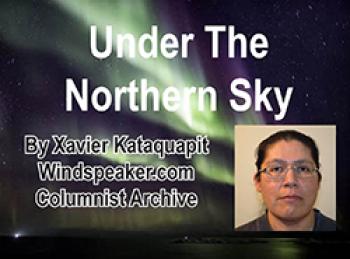Summary
By Xavier Kataquapit
I saw the full moon rise this past month and it is always a beautiful sight to see, especially in the fall. The orange glow of this mysterious orb in the sky lighting up the misty clouds on the horizon has always been part of our lives.
Most of us take it for granted and we don’t look up at the night sky often. I am also guilty of this. Many times I find that my life gets busy with so many distractions and events that I forget to look up at the night-time sky and marvel at the beautiful phenomena.
In Cree we call the moon, Tee-pees-kee Pee-sim, which basically translates as ‘the night sun’. The first part of the word Tee-pees-kee refers to the night which is called Tee-pees-kah-oo, and the second part of the word ‘Pee-sim’ is the word for the sun. The two words together in Cree simply describes the moon as the night-time sun.
This celestial object plays a big part in many cultures in our world. It generally marks the seasons of the year and many groups of people all through the ages have noticed the changes of the moon during the year.
It marks time and in some religions it plays a prominent role, most notably in the Muslim religion where they identify the season of Ramadan according to the cycles of the moon. In China and other parts of Asia, they have the Mid-Autumn Festival, or as it is also known as the Moon Festival or Harvest Moon Festival, which has been identified for more than 3,000 years.
Originally, this festival featured moon worship, traditions and beliefs all related to the moon and its changing cycles and its relationship to agriculture and the land. In Hindu traditions in India, the moon is known as the deity Chandra and it is identified as being part of the Navagraha, the "nine celestial bodies" which places the moon in equal prominence with the sun and major planets.
In the north on the James Bay coast, the moon plays a major role in our traditional lives as it marks the seasons of the year. We name our months according to the cycles of the moon and our calendar starts in the spring.
According to our Elders, our months are known as Mikisiwi-piisim (eagle moon), Niski-piisim (Canada goose moon), Aliiki-piisim or Aniiki-piisim (frog moon), Saakipakaawi-piisim (budding moon), Opaskowi-piisim (moulting moon), Ohpahowi-piisim (flying up moon), Wehwewi-piisim (blue goose moon), Opimahaamowi-piisim (migrating moon), Kashkatinisiw-piisim (freeze-up moon), Paapiiwaachakinishiish-piisim (little scattering moon), Kishe-paapiiwaatakini-piisim (great scattered about moon) and Kishe-piisim (great moon).
One lesson I remembered from my father Marius was in identifying Kishe-piisim (the great moon), which corresponds to February, the coldest month of the year. During this frozen time of the year, you can see the moon taking an unusual orientation in the sky. As Kishe-piisim wanes into a crescent shape, it begins to look like a ‘U’ shape in the sky and it is at this point that everyone knows that winter is at its peak.
It is hard to believe we have actually travelled to the moon and walked its surface. Why we have not been back in person since Apollo 11 in 1969, especially with all the technology we have created since, I can’t explain.
Perhaps we have just been caught up as a society with all of the action and ills of our very own little planet we call Earth. Perhaps the moon visit deniers are right and that the original voyage was never really made in reality but shot in a studio environment somewhere on Earth. I like to think although we have better technology and more resources it is merely because we have not had the political will to visit that very lonely man in the moon.
Other countries are every interested these days in travelling to the moon, and China recently sent up a spacecraft and did some roaming around. India also made a valiant effort to visit that great hunk of cheese in the sky but their craft ended up having a technical, mechanical problem.
I know one thing for sure about the moon and that is the fact that it really binds us together as a human race. No matter where you are on Earth when you look up to the night sky and focus on our wonderful moon you realize that there are millions of other humans doing the same thing.
The moon has always had a role in keeping us connected, guided and lit. Someday I imagine, if we don’t blow ourselves up or become extinct because of climate crisis, some of our future generations will be looking back at Earth from the moon. How cool would that be?

